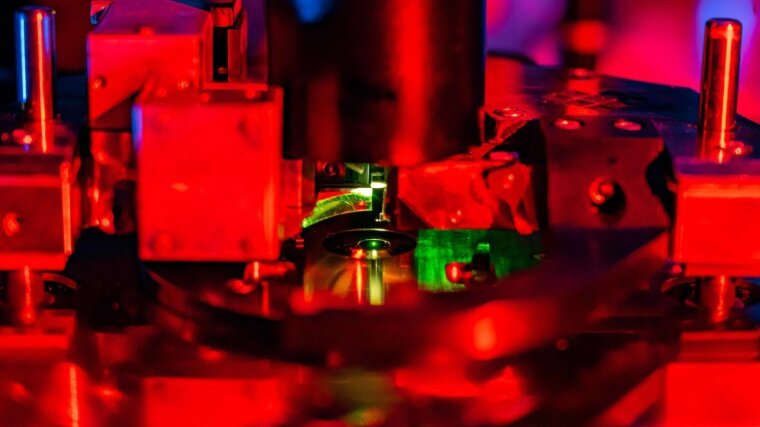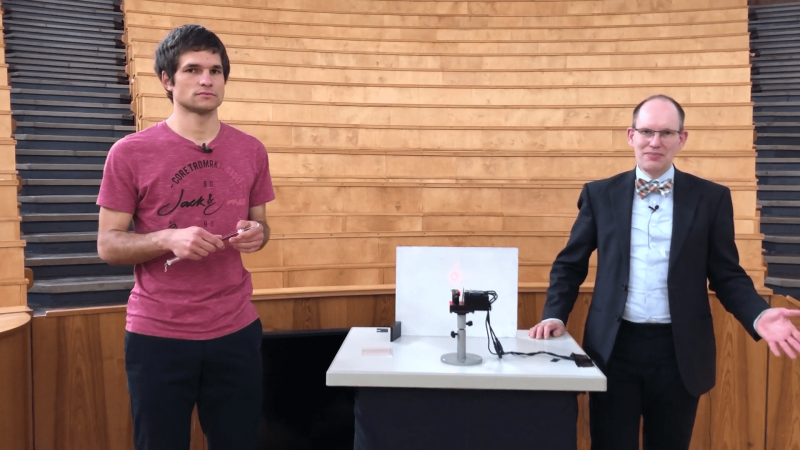
Optics is the oldest discipline in physics. While people in ancient times believed light originated in their eyes in the form of ›rays of vision‹, we now know that light is emitted by matter and registered by the eye. It is a wave and particle at the same time. Nothing moves faster and what we perceive as visible light is only a small part of a broad spectrum. However, we are yet to fully understand all aspects of the ›theory of light‹. While humans are not the origin of light, they have opened up a whole new chapter of physics in nonlinear optics.
By Ute Schönfelder
What is nonlinear optics anyway?
In order to answer this question, it might be useful to start by looking at traditional—linear—optics, which gets its name from the linear relationship between the light that enters and exits a body or medium. If a ray of sunlight falls through a windowpane, for example, a certain amount of light will come out on the other side. If twice as much light shines through the glass, the amount of light on the other side will also double. »And the light’s wavelength—that is, its colour—doesn’t change in linear optical processes,« explains Prof. Dr Gerhard Paulus, who teaches nonlinear optics at the University of Jena. »Red light is diffracted or refracted as a red ray; if I shine green light at an object, it will reflect green light.«
This is different in nonlinear optics, where a ray of infrared light that hits a crystal suddenly turns into green light. And unlike in linear optics, doubling the incident light will quadruple the amount of light that comes out, with double the frequency.
Why is that?
A crucial condition for such effects is the intensity of the light beam used. »Nonlinear optics can only be achieved with a very high intensity of light waves,« highlights Paulus. After all, nonlinear effects only occur when the rays are at least a billion times more intense than the sun, »so at electric field strengths of light waves that we don’t find in our everyday lives«. In order to bundle so many photons (i.e. light particles) into one ray, you need lasers. When uncontrolled, photons move in all directions at the speed of light. Channelling them into a coherent unit (i.e. with a uniform wavelength and identical phase of oscillation) is not possible without laser technology. In short, nonlinear optics was only a theory until the laser was invented in the 1960s.
Paulus explains what happens when matter is exposed to extremely intense light fields: The photons excite the material’s charge carriers (usually electrons) and stimulate vibrations. When the radiation intensity is low, Hooke’s law applies: The deflection of the charge carriers is proportional to the force applied (i.e. the field strength of the incident light waves). The more intense the radiation, the more the electrons vibrate and emit electromagnetic radiation. The light waves and excited electrons vibrate sinusoidally at low intensities. But when the intensity increases and the electrons are highly deflected from their orbit, their movements are distorted. As a result, the electrons not only emit light in the wavelength of excitation, but also at other frequencies.
Crystals with a certain lattice structure are particularly suitable for producing nonlinear optical effects. »In principle, however, all materials are suitable,« says Paulus. Nonlinear optical effects can even be generated in air.
What nonlinear optical phenomena are there?
Some of the most important effects include frequency doubling and high harmonic generation, as well as numerous other phenomena involving the multiplication and mixing of frequencies. Prof. Paulus and his colleague Dr Philipp Wustelt have made a video in which they explain a particularly impressive effect known as ›self-phase modulation‹. The essential requirement for all nonlinear optical processes is that light interacts with a suitable medium.
Why are we investigating nonlinear effects on nanostructures?
The processes involved in the interaction between light and matter particles are being examined in detail by teams of scientists at a collaborative research centre dedicated to ›Nonlinear Optics down to Atomic Scales‹. The researchers are particularly focusing on what happens when intense laser light interacts with nanostructures. Their aim is to gain a comprehensive understanding of such processes to enable the production of nanomaterials with tailor-made properties, which could be used as sensors, semiconductors or optoelectronic components.

